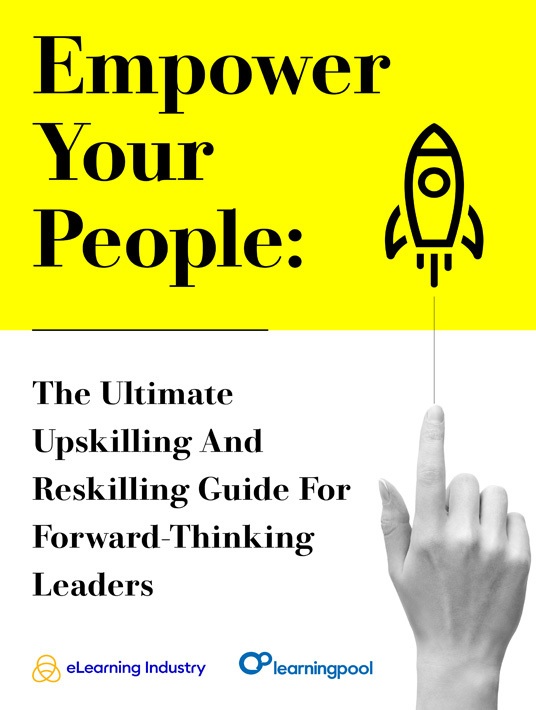Securing Tomorrow's Leadership With Upskilling And Reskilling
While addressing arising issues on the spot is usually a preferred method of risk mitigation, the future calls for solid, well-planned measures to potential business challenges. Companies today need to produce effective and capable leaders that will be able to skillfully navigate complex situations and create actionable solutions in the future. Certainly, upskilling and reskilling can be the remedy to this issue; it's no secret that today's business leaders were once high-performing employees with immense, untapped potential. So, are you ready to sift through your workforce to find your future leaders? Let's discuss how upskilling and reskilling potential leaders can help you design and implement appropriate measures to ensure business success.

Why Leadership Training And Upskilling Means Planning For The Future
Running a company doesn't merely involve approving reports and assigning tasks. Business leaders are in a unique position to address business needs, encourage their employees, and drive growth and innovation. Specifically, leaders are tasked with ensuring business continuity by making the right decisions and implementing the right solutions. They should be able to anticipate future gaps that may result in operational—or other—hindrances and plan ahead to eradicate them. Essentially, having high-functioning leaders helps to barricade an organization against the unpredictability of the future.
That's why succession planning is a vital practice. Companies need to make an effort to understand and prepare for the range of challenges a leader will face. In doing so, future leaders can be equipped with the necessary skillsets to ensure that safeguards are in place during their tenure. For optimal succession planning, it's not enough to simply appoint someone in an executive position and allow them to take the reigns. A leader requires a distinct, diversified skillset that can only be cultivated over time.
Upskilling and reskilling your current employees is your best bet. Not only do you diversify the pool of potential leaders and provide equal education and training opportunities to your staff, but also you expand your reach beyond the typical leader profile. Among your workforce, there's certainly more than one highly capable candidate with great leadership potential. One only needs to identify them and provide a comprehensive set of tools to nurture their innate qualities.
Upskilling And Reskilling Future-Ready Leaders
Learning and Development programs that aim to upskill and reskill employees are having their moment in the spotlight. These initiatives are valuable for creating and cultivating high-performing and capable talent to populate key positions in an organization. Moreover, upskilling and reskilling allow companies to single out exceptional performers with the highest potential—employees that showcase a continuous growth mindset or possess some great leadership qualities. Character skills are usually what you should be looking for. Through practical experience and training, all other coveted leadership qualities will surely follow. Here are some potential tactics to employ if you wish to identify possible leaders in your organization.
1. Training Performance Evaluation
Companies on the path to identifying potential leaders need to carefully assess their training strategies and the accompanying results. By setting tangible, individualized objectives, they will be able to measure individual performance and goals met with much more precision. Thus, through training performance evaluation, organizations will be able to detect skill gaps and assess individual progress so that their training is adjusted accordingly. In addition, they can use these performance evaluations to recognize and single out top performers and eager learners much more effectively, further aiding their cause to locate a future-ready leader. Lastly, through skill-building evaluations, enterprises have the unique advantage of measuring character qualities and soft skills that are vital for leadership. Qualities like high emotional intelligence and empathy will help them secure talent that will thrive in a leadership position.
2. Structured Skills Assessments
Just like training performance evaluations, assessments serve a similar purpose; to collect data, identify training needs, evaluate results, and measure training effectiveness and individual performance. However, assessments can sometimes be much more structured in nature, since they are targeting specific aspects of a person's upskilling or reskilling journey. They are extremely useful for skills measurement by assessing an employee's competencies and areas needing further development. Hence, they are usually preferred for measuring practical or hard skills instead of character qualities that are so coveted in leadership training circles, despite the fact that assessments are actually quite malleable and can easily be adapted for different use cases. Whatever way you choose to implement them in your upskilling program, they'll certainly prove to be instrumental in its success. All in all, assessments provide the data necessary for informed decision making, rendering them extremely valuable for companies looking to upskill future leaders.
3. Targeted Resources
To further aid the journey toward upskilling and reskilling tomorrow's leaders, let's discuss tailored content. Personalized learning materials have become the bread and butter of many L&D leaders, while many more are just starting to realize their potential. By providing targeted, personalized resources during leadership training, you ensure that your candidates will receive individualized, context-specific training that's centered around their job role, performance, learning needs, and personal aspirations. Targeted resources can also help fill skill gaps with more precision, increase engagement with the training content, and attract a diverse learner pool of potential leaders that are hoping to get upskilled. Lastly, through personalized resources, identifying future leaders has never been easier; tailor your content to your candidates' needs and see how they thrive.
4. Role Fit
Are you sure that the right people are in the right positions? Surely, if not, they get by just fine, right? Probably not. Role fit is an essential part of the hiring process. Deciding on whether your finalists would be able to adapt to the duties of their role, specifically within the context of your company, is all part of the process. However, if you're currently in the middle of some business makeover—restructuring operational processes, mission statements, or allocating talent—make sure to take it into account. By considering the power of role fit, companies can ensure that each position is filled with a person possessing the right qualifications. Leveraging this tactic means you can single out your top performers and, with some upskilling and reskilling, help them grow into capable leaders.
Conclusion
Upskilling and reskilling initiatives have a significant role to play in tomorrow's business landscape. Companies on the track to create leadership development strategies and identify future leaders can utilize important components of upskilling and reskilling to design and implement a winning L&D program. Ultimately, current employees who have the potential to succeed in leadership roles should start further nurturing their qualities. Training to become a leader is a necessary part of the process. To leverage upskilling and reskilling to identify and train tomorrow's leaders, you need to get started today. No time to lose.
Download Empower Your People: The Ultimate Upskilling And Reskilling Guide For Forward-Thinking Leaders today to attract, retain, and fully engage top talent.

